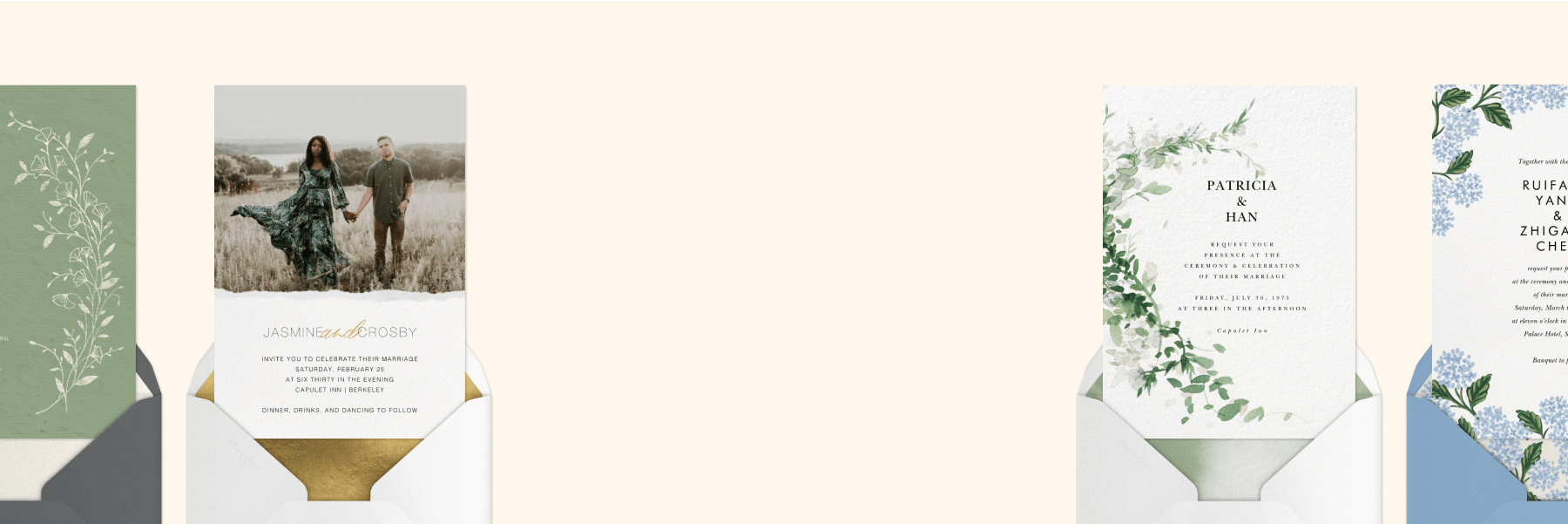6 Simple Tips for Building Your Wedding Guest List
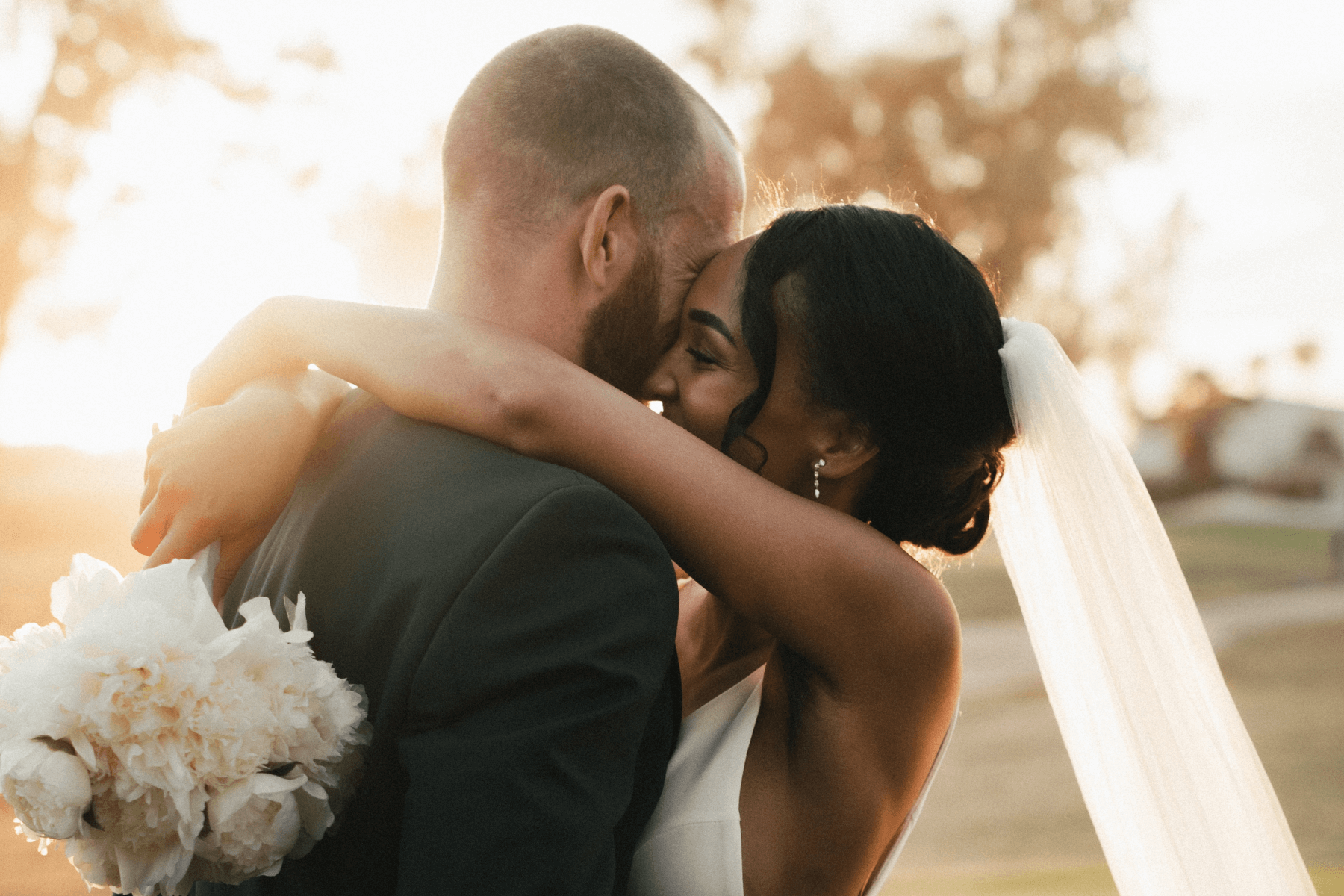
Aside from the all-important answer to “Will you marry me?”, planning a wedding comes with plenty of choices—like tastings for delicious cakes, finding the dress, and deciding on the perfect venue. Some of these decisions might be as simple as a joyful “Yes” (divine double chocolate cake, we’re looking at you). But one that might have your head spinning is the question of who to put on your wedding guest list.
If you’re having trouble building your guest list, don’t fret. The process might not be as delicious as that cake tasting, but with some simple tips and guidelines, you’ll be able to plan, organize, and manage your list like a pro.
To help you with your own guest list, we gathered meaningful anonymized insights into wedding invitations and guest lists from our over 13 years of service as a trusted online invitation platform for engaged couples. In this analysis, we compare wedding invitation trends from the 6 month period before the publication of this article on (July 6, 2022).
Table of Contents
1. Establish some guest list guidelines before you start
You may want to share your celebration with everyone you’ve ever met, but unless you have an infinite wedding budget, you’ll likely need to narrow it down.
Giving yourself a few guidelines can be a helpful way to decide who’s invited in the first place. Even more importantly, being consistent with your rules can help you treat your potential invitees with fairness and grace (and avoid making anyone feel unnecessarily left out).
Here are a few guidelines to start with:
- Plus ones: Generally speaking, it’s a good idea to include the significant others of any friends or family who are in serious relationships. Some wedding planning experts recommend inviting plus ones for couples who live together, or who have been in a relationship for more than a few months. Whatever rule you decide on, be sure to apply it consistently, especially when it comes to slippery plus-one situations – like if your dad has a new girlfriend or if you’re friends with a divorced couple who both want to bring their new spouses.
- Kids: Deciding whether you’ll invite children to your wedding can help you provide clear communication to families. If you do invite children, keep in mind how you’ll include them in your overall wedding plans—such as offering a kid-friendly menu and whether you’ll provide activities or babysitting services at the reception. If you decide that you’d like to keep your wedding guest list adults only, make sure that parents know sooner rather than later. Try breaking the news gently, for example: “We adore your kids, but we want to give the grown-ups a night off—Adults only please!” or “We hope you will understand our choice to make the wedding adults-only, we hope you’ll take the opportunity to let loose and celebrate with us!”
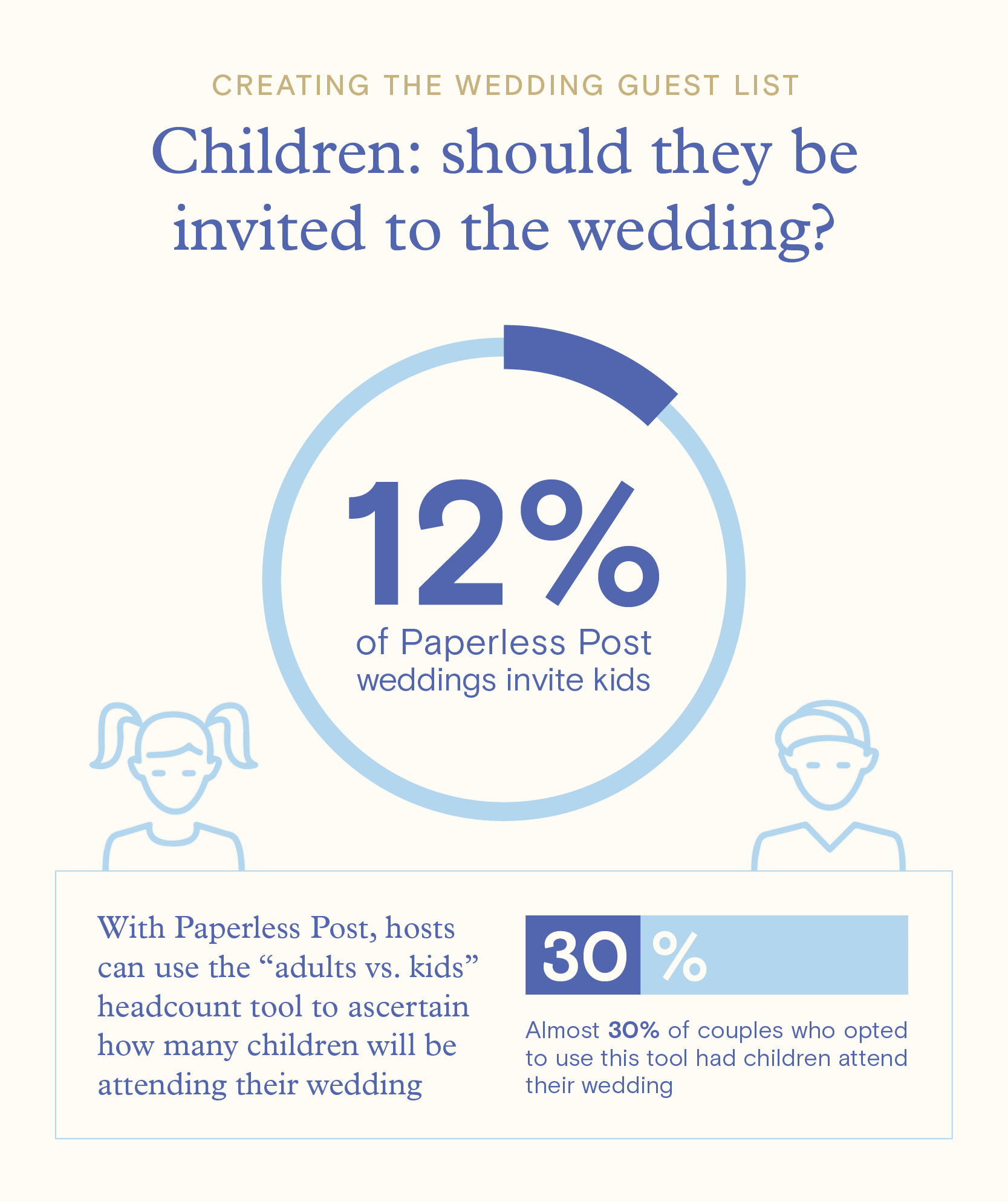
- Extended family: Decide whether you and your future spouse want to invite certain categories of extended family, and apply that rule evenly. These may include aunts and uncles, first cousins, or even second cousins. Rule of thumb: if you haven’t spoken to the family member in more than a year, they don’t have to make your list.
- Coworkers: This category can be tricky, but a few clear-cut rules can help here, too. If you can’t invite your whole department or prefer not to, consider inviting just the coworkers you enjoy spending time with outside of work. You might also wish to invite a supervisor or mentor who has supported you at work. On the other hand, if you don’t want to invite anyone from work, that’s fine too!
2. Decide how to split the wedding guest list
Some wedding traditions might dictate that you have to split your wedding guests between two halves of the aisle—and divide your wedding guest list accordingly. In reality, however, you and your partner can be as flexible as you want as long as you make it a collaborative process.
For example, your spouse-to-be may have an enormous extended family, but your own family could be comparatively small. Or, one of you may have a large friend group, while the other keeps a tight-knit group of close friends. It’s okay to be flexible in either situation—just be sure to communicate with each other about your wishes for the guest list. (You also definitely don’t have to confine your guests to one side of the aisle.)
You may also wish to allow your parents and in-laws to invite a few of their own guests, such as their close friends and coworkers. If you choose to do so, decide what percentage of your guest list each parent can invite and be consistent between them. In addition, be sure to communicate the guidelines you’ve already set about plus ones, children, and any other guests.
It can be helpful as a couple to create a spreadsheet of all potential guests with cells like “[name of future spouse and whose side they’re from]” or “both spouses” (if it’s a common friend of the couple). Other tags that are helpful are “family” or “friend”, and for big weddings, you could even include cells like “single” or other attributes or interests that help with balancing the list and determining seating arrangements.
3. Make a rough draft before finding a venue
Perhaps you’re dreaming of a laid-back beach wedding, or maybe your ideal setting is a grand cathedral. Even if you have a specific venue in mind already, it’s a good idea to sketch out the guest list before making any final decisions about your venue.
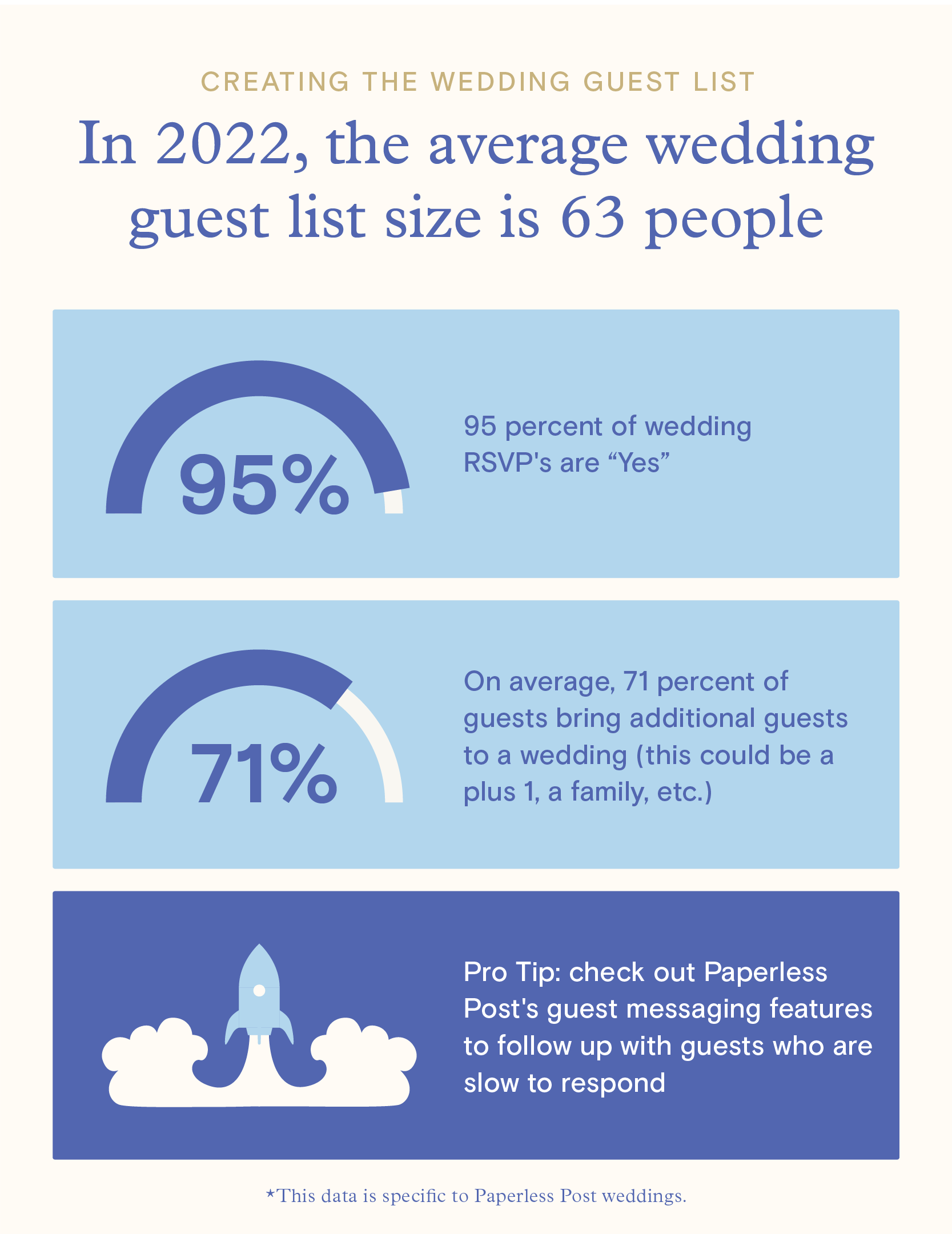
Some venues might have limitations on the number of guests they can handle—but they may also require you to pay for a minimum number of guests, regardless of how many actually attend. Choosing a venue with your guest list in mind can help you to make sure there’s room for everyone and that you’re not overpaying for your total count.
Once you and your partner have your rough estimate, ask yourselves these questions to find a balance between the perfect venue and the right number of guests:
- Does your preferred venue have any limitations or requirements on the number of guests you invite?
- How much can you budget per guest for venue and catering costs?
- If the venue provides catering, do you have to pay for a certain number of guests in advance, or can you adjust your numbers as needed?
Here’s a simple math formula to help you calculate the total cost of all of your guests:
# of guests x $ per person = cost of all wedding guests
Or, if you already know how much you want to spend on all of your guests, use this formula to see how much you can spend per person:
cost of all wedding guests / # of guests = $ per person
So, if you have 125 guests and your venue and catering costs are $100 per person, the cost for all wedding guests is $12,500.
125 guest x $100 per guest = $12,500 = cost of all guests
4. Refine your guest list
Your first-grade teacher, that friend from high school, your college roommate—deciding who to invite to your wedding can have you reflecting on all those who’ve ever impacted your life. Once you have your rough draft, how do you figure out who makes the final cut and who you’ll decide not to invite after all?
In truth, it’s all about determining whose presence will mean the most to you. This may sound like a tricky task, but a few simple questions can help you to narrow it down.
As you begin refining your list, consider the following:
- Has the guest met both you and your future spouse?
- Will the person be a part of your life following the wedding?
- Have you communicated with this person in the last one to two years?
- If they are married, were you invited to attend their wedding?
- Will you look forward to seeing and talking with them at your wedding?
- If they’re a coworker, would you and your spouse continue to see them if you or they left that job?
At the end of the day, your guests should be those people you’ll remember sharing this meaningful day with. Prioritizing their presence can make your actual wedding day even more enjoyable.
Should your wedding have a B-list?
Building your guest list is one part of the puzzle, but receiving the actual RSVPs is another. According to some wedding planners, you should expect a lot of guests to not RSVP at all, and about 1% of invited guests to decline the invitation.
The question, then, is what to do with that empty space—and whether you should have a backup list, or B-list, to fill the spots of those who decline.
Having a B-list can be complicated, as it can require inviting additional guests last minute. You also need to be careful not to make any B-list guests feel second-best. For some couples, sticking with your initial list can help to simplify the process. However, there are some cases when having a B-list can be a good choice.
A few examples include:
- If you wanted to invite more people initially, but couldn’t accommodate them in your venue or budget
- If you at first decided to cut certain guests—like childhood friends or second cousins—but would have liked to include them if you had the space
- If you’ve already committed to a certain number of people for your venue and catering, and would enjoy having the extra attendees at the wedding
If you do decide to have a B-list, be careful to give them plenty of time for their own RSVPs and be tactful about how you invite them.
Tips for handling those who aren’t invited
With the excitement weddings can bring, word about your upcoming nuptials can spread. It might not be too much of a surprise, then, when someone asks you about your big event. But what if someone who’s not on your guest list asks if they’re invited?
If someone asks directly if they are invited, you only need to politely communicate your regrets that you couldn’t include them. If you’d like, you can even mention your limitations (venue, small overall event size, large family, or otherwise) as a reason—but you aren’t obligated to do so.
5. Strategize your invites (paper and digital)
Once you know who you want to invite to your wedding, when do you let them know the good news? Here are a few rules of thumb for sending out your wedding Save the Dates and invitations:
- Send Save the Dates at least 4–6 months before the big day (the longer the lead time, the better)
- Send invites at least 8 weeks in advance
Our advice? The earlier you send out your invitations, the sooner you can get an accurate head count for food, party favors, and all the other little things that go into wedding planning. In fact, most Paperless Post couples send the actual wedding invitations about 10 weeks ahead of time.
Digital Save the Dates might just be your wedding-invite secret weapon. They’re quick to send out and can come with a digital address request for your guests. That way, when it’s time to start addressing those envelopes, you’ve already got your guest list and their contact information ready to go. It’s a brilliant system, and it’s why 29% of Paperless Post Save the Dates collect guest physical mailing addresses.
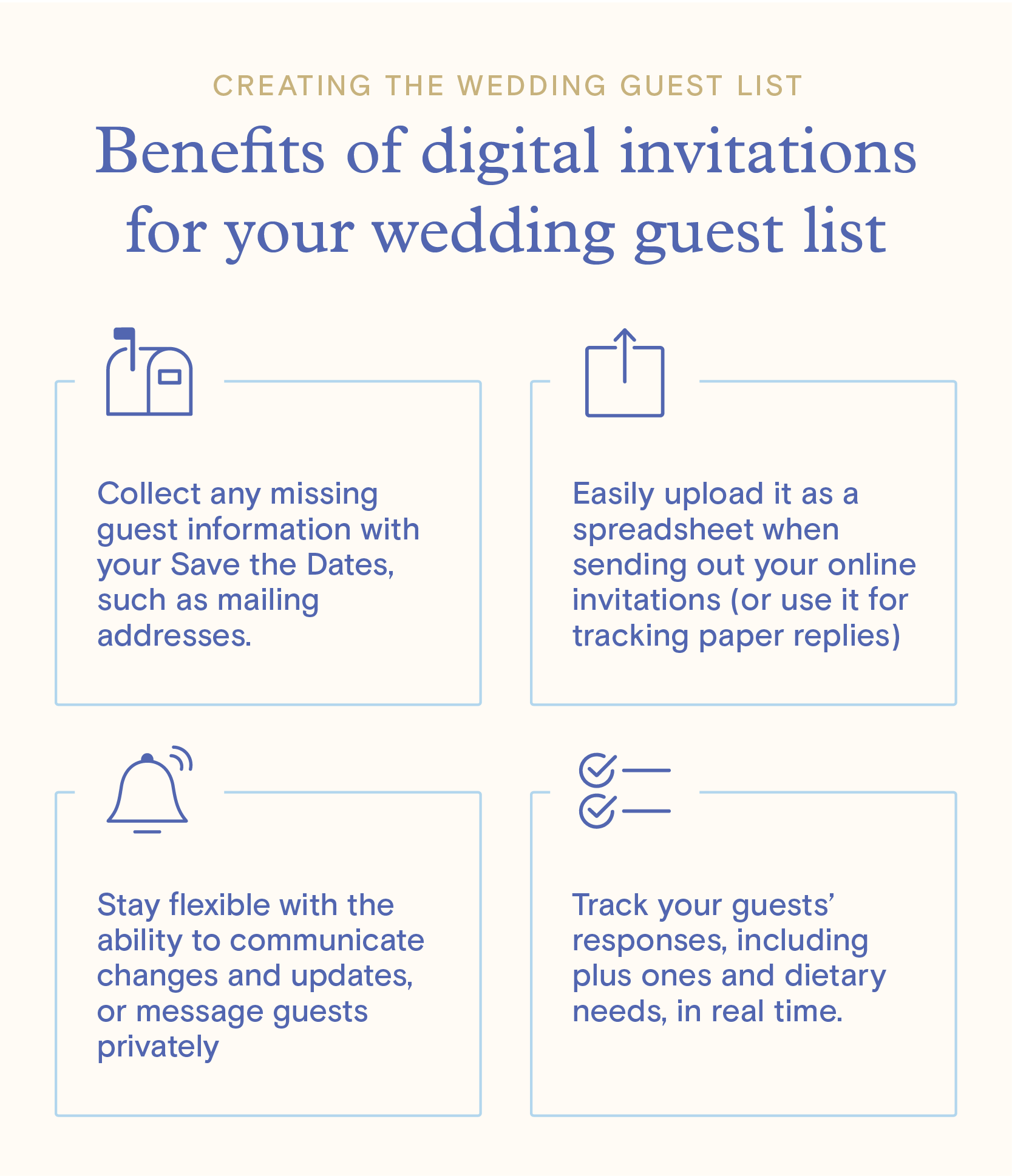
If you love the ease of a digital Save the Date and still want the feel of a classic paper invitation, Paperless Post has got you covered with our exclusive print partner, Paper Source!
6. Build your wedding guest list with Paperless Post
Using a smart system to keep track of your guests’ info, track their replies, and send updates can provide a lot of relief when it comes to your wedding plans. As you pick out the perfect save-the-dates and invitations, look for an option that seamlessly integrates all of these features, like Paperless Post.
Whether you plan to invite 15 guests or 500, planning your wedding guest list can be a wonderful opportunity to look forward to sharing your love with all those you care about. But don’t forget another important piece of your planning—finding the perfect save the dates and wedding invitations to welcome your guests to the big day.
At Paperless Post, we want to help you simplify as much of your wedding planning process as possible. While we are aware that some things can’t be solved with software (where to draw the line with +1 inclusion?), guest list communication and management can be greatly simplified. Our best-in-class online save the dates and online wedding invitations make it easy to track RSVPs, send guests updates, and share information about your wedding day.
Crossing off wedding headaches so you can focus on your real party priorities? We’ll toast to that.
Customizable designs from Oscar de la Renta, Rifle Paper Co., kate spade new york, and more.
